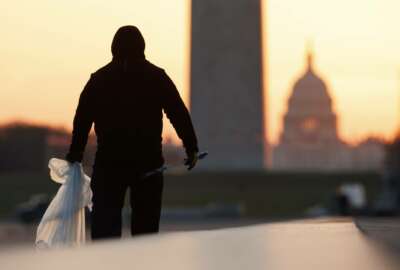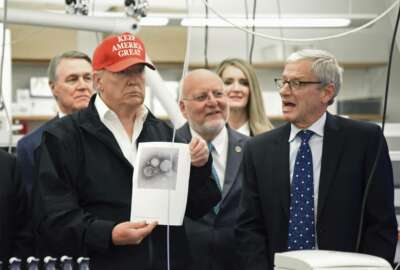
White House details how agencies should call back federal employees, resume ‘normal’ operations
Agency heads now have a detailed decision-making framework from the Trump administration, which describes how, consistent with local conditions, they should...
Best listening experience is on Chrome, Firefox or Safari. Subscribe to Federal Drive’s daily audio interviews on Apple Podcasts or PodcastOne.
Agencies have new guidelines now from the Trump administration, which detail how, consistent with local conditions, they should gradually begin to reopen federal offices and call their employees back from mandatory telework programs during the coronavirus pandemic.
The guidance, which acting Office of Management and Budget Director Russell Vought and acting Office of Personnel Management Director Michael Rigas released Monday afternoon, gives agency leaders a framework to make these decisions.
The framework mirrors the national guidelines the White House released late last week, which charged individual states with meeting certain “gating criteria” before reopening the local economy in phases.
“The federal government has a critical role to assist and lead the national recovery,” Vought and Rigas said. “This guidance provides the framework for agencies to take immediate actions to begin adjusting their operating status for a controllable, steady return to normal operations, and align agency operations through the “gating period” and the three-phase framework in the national guidelines. Federal government-wide operating decisions will be informed by states’ phasing assessments and conditions, but implemented at the direction of agency heads or as delegated by the agency head.”
The guidance describes a tricky balancing act for agency heads, who must weigh the conditions, testing and hospital capacity within the states and counties where they reside — as well as status for all states and regions where the organization operates.
These state and regional assessments will serve as a starting point for agencies. But they must also consider school and childcare closures, mass transit availability, parking availability, facility requirements and their missions.
Operating plans may even differ depending on individual positions or missions within the agency.
“Mitigation measures for an office worker will likely look much different than the measures for those who perform their jobs in a non-office setting and would result in potentially different operational phasing and mitigation decisions even within a single geographic location,” the guidance reads.
Agencies should coordinate their decisions for reopening regional federal offices with OPM and OMB, Vought and Rigas said.
OPM may, for example, coordinate a response for the national capital region, as it has done for snow and severe weather days in the area. But as 85% of the federal workforce resides outside of the Washington metropolitan region, there will likely will be a wide variety of reopening plans and operating status updates that may differ depending on location, mission and agency.
And because each agency may take a different approach to reopening in each state, departments must post their operating statuses for each facility on their websites, the guidance said.
OPM will keep a compilation of this information on its own website.
“By acting early and decisively, President Donald Trump has ensured the government remains open and essential services continue to be provided to the American public throughout the coronavirus emergency,” an OMB spokesman said in a statement to Federal News Network. “Now as conditions warrant across each state, federal agencies will be able to return operations to normal. This administration remains committed to serving the American public. Our federal workers have shown tremendous fortitude in keeping the U.S. strong.”
A gradual lift on telework in phases
It’s still up to agency heads to make their own decisions about telework moving forward, Vought and Rigas said, though they urged leaders to consider continually revising or tweaking their telework policies to reflect local conditions and mission needs.
All “high risk” federal employees who are eligible for telework should continue to work remotely — and may continue to do so through the gating period and at least the first two phases of the reopening framework.
“Until agencies have resumed normal operations and risk is minimal, all federal agencies are encouraged to maximize telework flexibilities to all eligible workers within those populations
that the CDC has identified as being at higher risk for serious complications from COVID-19 and to CDC-identified special populations including pregnant women, regardless of location,” the guidance reads.
The framework then describes a “gating period” and three additional phases for instituting telework policies, again, based on geographic location.
Under the “gating period,” agencies should keep working under the current “maximum telework flexibility” operating status, which OMB implemented back on March 18. This period will give states, as well as the agencies, the time needed to determine whether it’s safe to gradually reopen parts of the local economy.
Once a state has finished its assessment, agencies may advance to phase one, where they should lift mandatory telework requirements. Agencies should encourage telework “wherever possible” in these regional areas, but it’s not required.
Agencies should lift maximum telework policies at phase two.
“In general, employees could potentially begin resuming normal telework arrangements in these areas,” the guidance reads. “Before requiring employees to resume normal telework arrangements on a widespread basis, agency leaders should assess employees’ needs, such as childcare and transportation. Agency leaders may also establish alternative service levels or work arrangements to reduce the number of individuals in an office to promote social distancing.”
The guidance for phase three doesn’t offer much detail, but it does suggest agencies may choose to enter into new work arrangements with their employees.
“Agencies may create cohorts or teams within an office and place the cohort or team on alternating schedules of five days in the office and 15 days of telework per month,” Vought and Rigas said. “Adoption of alternative arrangements such as rotating cohorts may enable additional flexibility for employees to resume normal operations, regardless of phasing status, while maintaining social distancing and reducing contact among work units.”
In addition, agencies should continue to grant weather and safety leave to high-risk employees, as well as those who can’t safely travel to their typical duty stations.
Agencies may, according to the guidance, continue to grant excused absences to federal employees if schools and day care centers stay closed, but only on a limited basis.
Federal employees may wear masks at the office
The OMB and OPM guidance also offers up some precautions agencies should take to protect federal employees who are at high risk for the coronavirus, as well as those over the age of 65.
Employees in good health and under the age of 65 may return the workplace, consistent with state and local guidelines.
“Employees may wear a face covering at all times while in the workplace,” the guidance reads. “Agencies can issue facemasks or may approve employees’ supplied cloth face coverings.”
In addition, it’s up to each agency’s building mission to set screening procedures and social distancing standards.
Agencies may, for example, consider closing common areas or banning shared food in the office buildings. They should also ensure they have hand sanitizer, soap and toilet paper on hand, the guidance said.
They may also set screening procedures for both employees and visitors to federal facilities. Agencies may, for example, ask employees to take their own temperatures at home before coming to the office.
“These agency policies must include specific considerations for federal employees, contractors and visitors,” the guidance reads. “Agencies may consider purchasing facility screening services (including basic health screenings and temperature checks) now available on the GSA Schedule, subject to availability.”
And finally, the guidance advises agencies with customer-facing missions, including national parks, Social Security offices, Small Business Administration loan offices, Department of Veterans Affairs facilities and others, to make a special effort to resume normal operations.
“Agencies must prioritize capacity building for those services that are the most public-facing as well as those critical to implementing COVID-19 response efforts to help the nation’s recovery,” the guidance reads. “For those agencies with a customer-facing mission, agencies should determine how to prioritize reopening properties and facilities and provide increased public access to these facilities in a manner that is consistent with the national guidelines.”
Copyright © 2025 Federal News Network. All rights reserved. This website is not intended for users located within the European Economic Area.
Nicole Ogrysko is a reporter for Federal News Network focusing on the federal workforce and federal pay and benefits.
Follow @nogryskoWFED






